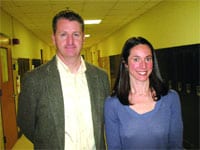Let’s Do More to Prevent HPV
The medical world is awash in alphabet soup, made more familiar by news reporting and the many direct-to-consumer television commercials we see every day. From AFIB (atrial fibrillation) to COPD (chronic obstructive pulmonary disorder); from PAD (peripheral artery disease) to RA (rheumatoid arthritis), it seems almost every condition or test (EKG, MRI) gets whittled down to just a few letters, with the hope of raising awareness and speeding communication between physician and patient.
Let me offer three more letters young boys and girls, and especially their parents, should remember: HPV.
It stands for human papilloma virus, and it’s the most common sexually transmitted infection. With the exceptions of flu and pneumonia, HPV hurts and kills more Americans each year than all other vaccine-preventable diseases combined. HPV can lead to genital warts and certain cancers, including cervical cancers and head and neck cancers.
Each year, 12,000 women in the U.S. get cervical cancer, and 4,000 die from their disease. Meanwhile, 11,000 men and women get cancer of the head and neck, and HPV leads to 75{06cf2b9696b159f874511d23dbc893eb1ac83014175ed30550cfff22781411e5} of these cancers. No screening test exists, and treatment for the condition causes permanent disfigurement and disability. In addition, 5,000 men and women get anal cancer, with two-thirds of cases occurring in women. Routine screening is not available for this type of cancer.
The good news is that many of those numbers — including up to 70{06cf2b9696b159f874511d23dbc893eb1ac83014175ed30550cfff22781411e5} of cervical-cancer cases and 90{06cf2b9696b159f874511d23dbc893eb1ac83014175ed30550cfff22781411e5} of genital warts — can be prevented with an HPV vaccine that blocks infection from four different types of the virus. The Advisory Committee on Immunization Practices of the U.S. Centers for Disease Control and Prevention recommends that every boy and girl 11 or 12 years of age get the vaccine, with vaccination permitted as early as age 9 and catchup shots recommended through age 26 for girls and age 21 for boys.
The not-so-good news is that barely more than half of girls (53.8{06cf2b9696b159f874511d23dbc893eb1ac83014175ed30550cfff22781411e5}) and just over 20{06cf2b9696b159f874511d23dbc893eb1ac83014175ed30550cfff22781411e5} of boys have been vaccinated, and only two-thirds of the girls who did get vaccinated received the recommended three doses. Further, not one state in the nation met the HPV vaccination target of 80{06cf2b9696b159f874511d23dbc893eb1ac83014175ed30550cfff22781411e5} set for girls by National Healthy People 2020, a project of the U.S. Department of Health and Human Services.
The vaccine is safe and effective. More than 30,000 patients were vaccinated during clinical trials, and more than 100 million doses have been distributed worldwide to date. The two largest studies, of 200,000 girls in the U.S. and 1 million girls in Denmark and Sweden, found no increase in any of 200 categories of illness.
The vaccine has also proven to be highly effective. In Australia, 80{06cf2b9696b159f874511d23dbc893eb1ac83014175ed30550cfff22781411e5} of girls have received three doses of the vaccine, and the incidence of genital warts has nearly disappeared among young women, while rates of cervical pre-cancer have declined up to 80{06cf2b9696b159f874511d23dbc893eb1ac83014175ed30550cfff22781411e5}. In the U.S., rates of HPV infection have decreased by 56{06cf2b9696b159f874511d23dbc893eb1ac83014175ed30550cfff22781411e5} in teens, and rates of cervical pre-cancers have decreased in women under age 24.
For parents asking why such a vaccination should be given at 11 or 12 years of age, the answer is that it produces a better immune response before age 14. Also, HPV can be passed by any skin-to-skin contact, not just by sexual intercourse, and vaccines work only if they’re given before exposure (pre-teens are less likely than older teens to have started sexual experimentation or activity). Physicians never wait until a child is at risk to give recommended vaccines, because that’s not how vaccines are designed to work. That’s why it’s important to start the shots at an early age and finish the recommended dosage of three shots within six months.
For those concerned that such a vaccine will promote unsafe sexual behavior, one study of teens showed no difference in sexual behavior, and a different study looking at high-risk teens actually found increased rates of safe sexual practices among vaccinated girls compared to those unvaccinated.
Imagine how many cases of cancer could be prevented if all those recommended to get the HPV vaccine would actually get vaccinated.
Vaccines are some of the greatest achievements in medicine, have an extraordinary record in preventing disease, and are one of the most potent weapons we have for personal and public health. Let’s use them to our ultimate benefit. For more information on HPV and vaccines, visit www.cdc.gov/hpv.
Dr. Rebecca B. Perkins is assistant professor of Obstetrics and Gynecology at Boston University School of Medicine/Boston Medical Center. This article is a public service of the Mass. Medical Society.


Comments are closed.